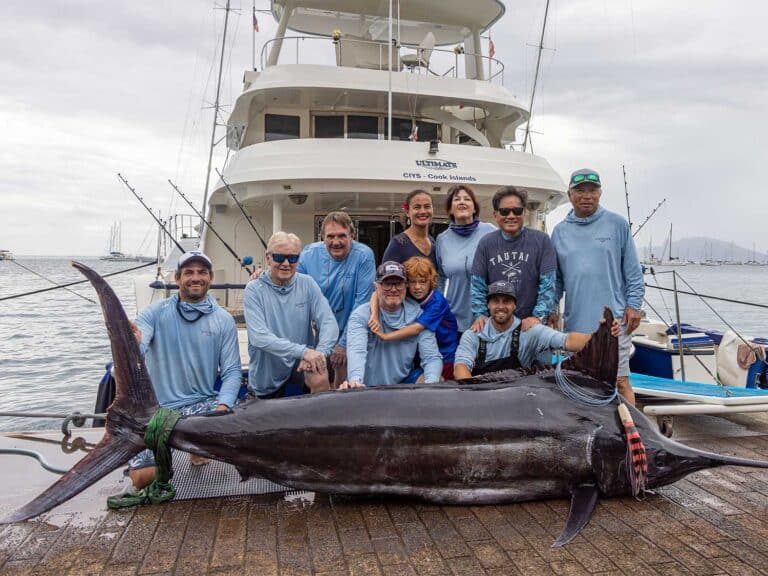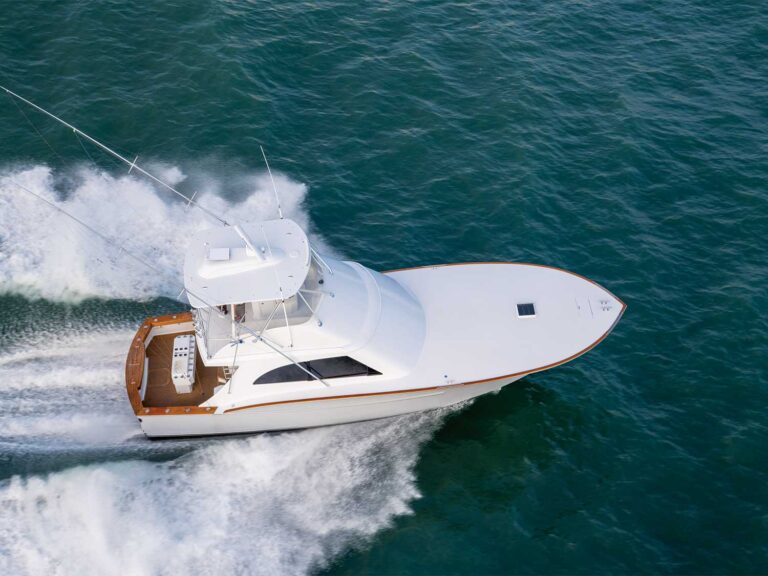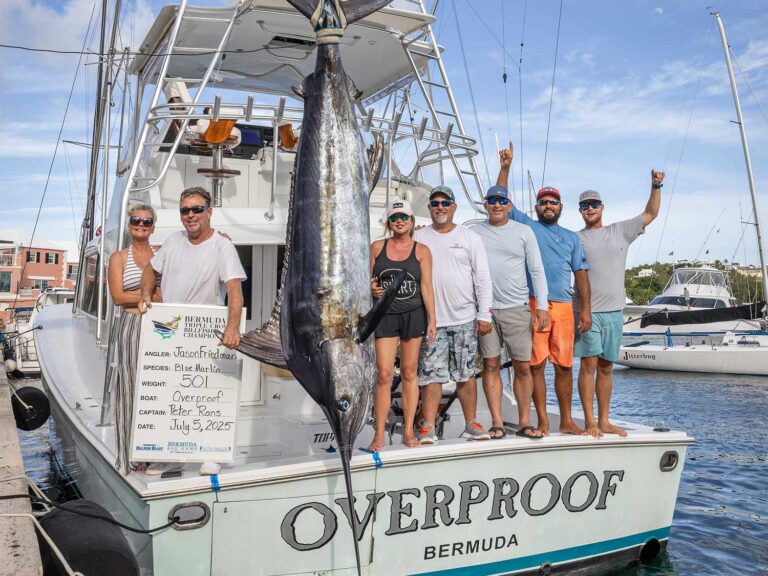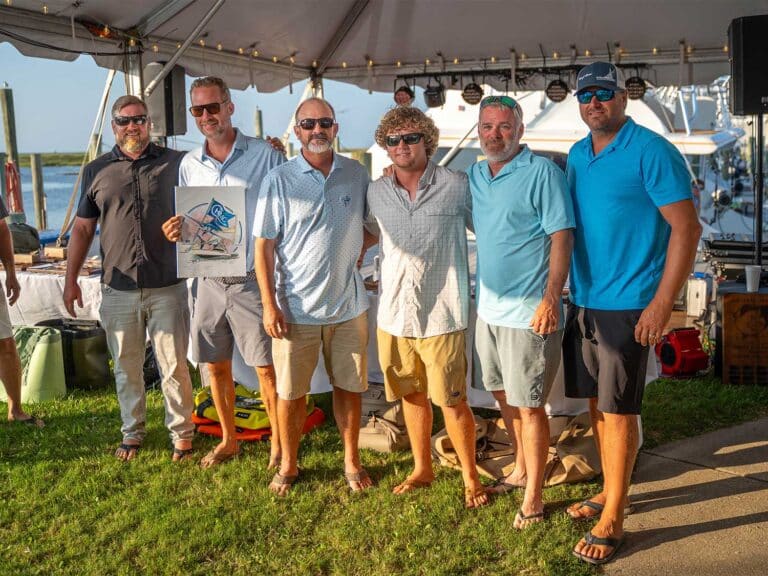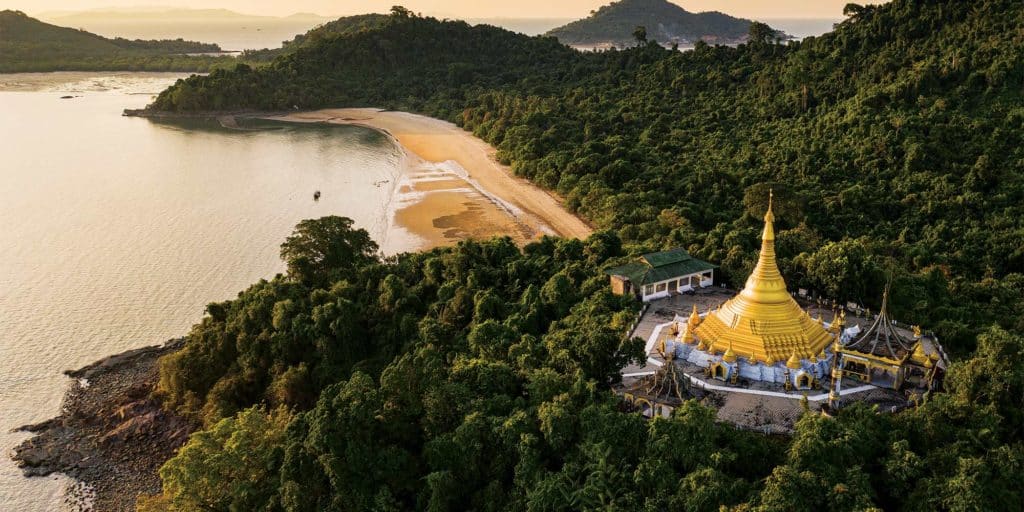
“You’re going…where?”
That’s the usual reaction when I explain that I had the opportunity to fish not only a beautifully exotic destination in Southeast Asia, but also one that has received almost zero exposure. Only a handful of well-traveled anglers and captains have even heard of the Andaman Sea, much less witnessed the nearly unlimited potential it holds. The phrase “undiscovered hot spot” gets thrown around a lot in the media these days, but this remote corner of the Indian Ocean rightly deserves it.
Fifteen and a half hours is a long time for self-contemplation. That’s the flight time from New York City to Hong Kong, just the second leg of a multi-day journey from Florida to the Republic of the Union of Myanmar, formerly known as Burma. In New York’s JFK airport, I hooked up with an old friend, Capt. Eddie Bairez. He had worked the past few seasons with our host, Brett Hall, fishing the waters from Malaysia to Thailand and north into the Andaman Sea, west of Myanmar. Hall extended an invitation for Marlin to join him and his brother, Mark, on an exploratory trip to fish the Burma Banks, a stretch of seamounts approximately 100 miles west of Kawthaung, Myanmar.
“We’re not exactly sure what to expect,” Brett wrote in an email, “but the marlin fishing should be pretty spectacular.”
That’s how I found myself winging my way over Canada’s frozen northern provinces at 45,000 feet, en route to the Far East for a 10-day adventure. The trip of a lifetime begins with the first step, but this was more like a flying leap into the vast unknown.
Hall is the mastermind behind Blue Oceans Adventures, a multiboat charter service that specializes in fishing, diving and surfing tourism. The lanky, personable Australian grew up marlin fishing and has maintained a lifelong passion for billfish even after a career move brought him to the island nation of Singapore.
We were fishing aboard the flagship of the Blue Oceans fleet: Hall’s 60-foot Bertram, Deja Blue, converted into a comfortable liveaboard and a perfect platform for multiday fishing expeditions. From Hong Kong, we continued by air to Bangkok, Thailand, then to the coastal Thai city of Ranong the following morning. From there, after crossing the Kra Buri River via long-tail skiff, we met Deja Blue on her mooring in the port town of Kawthaung, Myanmar. After two days of travel, we still had a 10-hour slow chug ahead of us, first winding through the beautiful tropical islands of the Mergui Archipelago, to reach the fishing grounds: the distant Burma Banks.
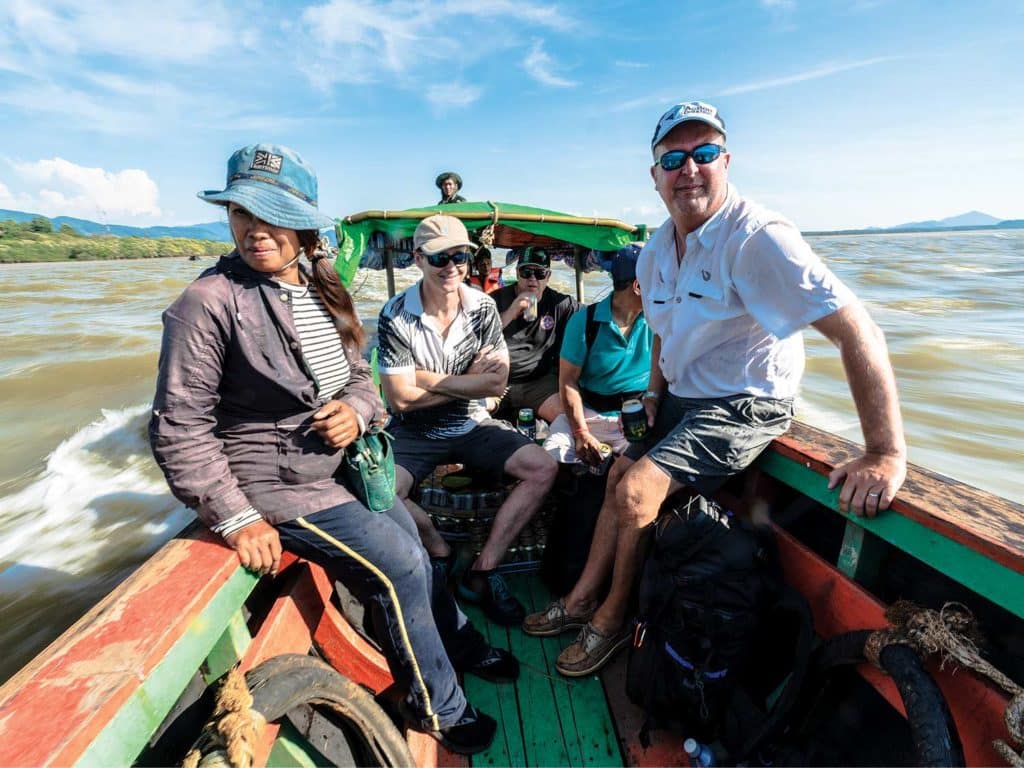
A New Reality
“But, is it safe?”
Those were the first words out of my boss’s mouth when I explained the purpose of the trip. And while Myanmar has certainly experienced its share of strife in its long and storied history, we would be transiting the country from Thailand at the slim southern peninsula.
We had absolutely no problems and found everyone, from government customs and immigration officials to the locals whom we encountered later in the trip, to be extremely friendly and welcoming to foreigners. Visiting vessels are required to have local guides aboard for the duration of their trips—ours was a super-friendly guy named Wind, who spoke very good English and works with Hall’s charters on a regular basis.
Myanmar is the largest mainland nation in Southeast Asia and about a third of the country is coastline, with 1,200 miles bordering the Bay of Bengal and the Andaman Sea.
Although the country’s foreign relations—with Western nations in particular—have historically been strained, the situation has greatly improved since its 2010 democratic elections and the reforms that followed. After years of isolation, the United States announced the resumption of diplomatic relations with Myanmar in 2012. Tourism, especially among Europeans, is steadily increasing.
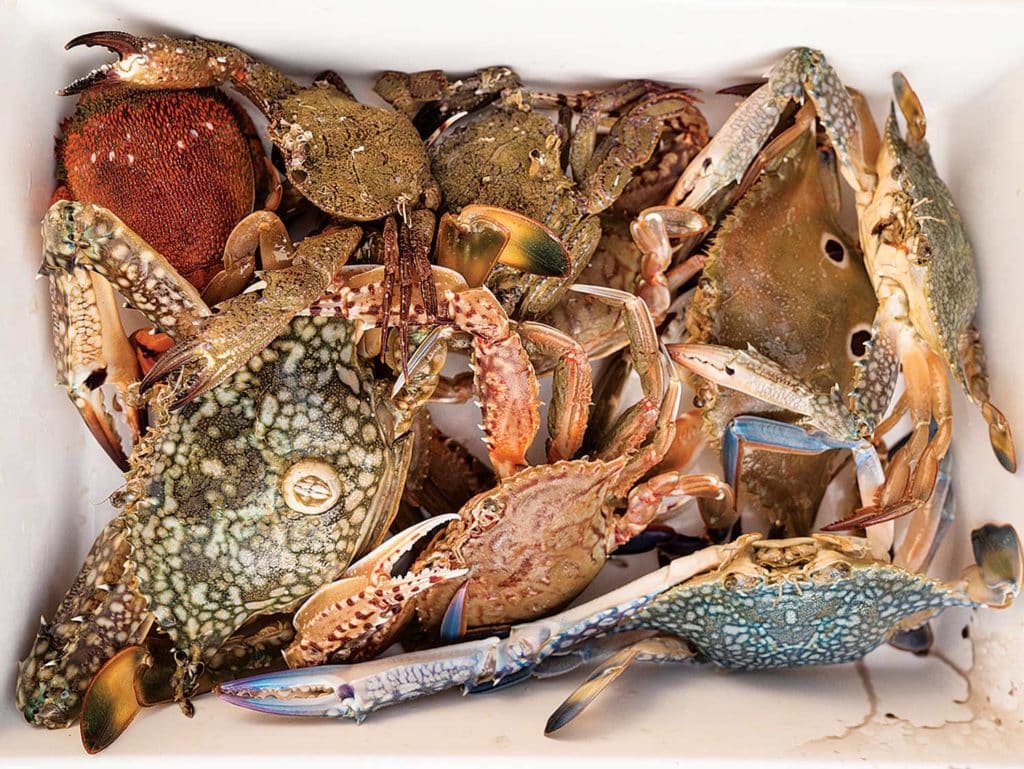
Fresh off the Boat
Uncharted Territory
The Burma Banks are a loose collection of seamounts in the Andaman Sea, which is in the western corner of the Indian Ocean between the Andaman and Nicobar Islands and Myanmar. There were only a few solid numbers in Deja Blue‘s chart plotter—it’s literally uncharted water. When I asked Hall about our game plan, he said, “Well, I spend a lot of time looking at this area using Google Earth. We can usually get pretty close to the seamounts we see there, and then we start looking for the structure.”
Hard to imagine, but it works. We also saw some absolutely world-class rips and current breaks—even when we worked away from the bottom structure—throughout the entire trip.
Because we had some ground to cover, Bairez elected to fish a traveling spread: a pair of large, active lures on 50-pound tackle from the riggers and two bridge teasers—a Flippy Floppy/Pakula combination on one side and a Moldcraft jumbo squid/Bobby Brown chase bait on the other—with pitch baits ready in each corner.
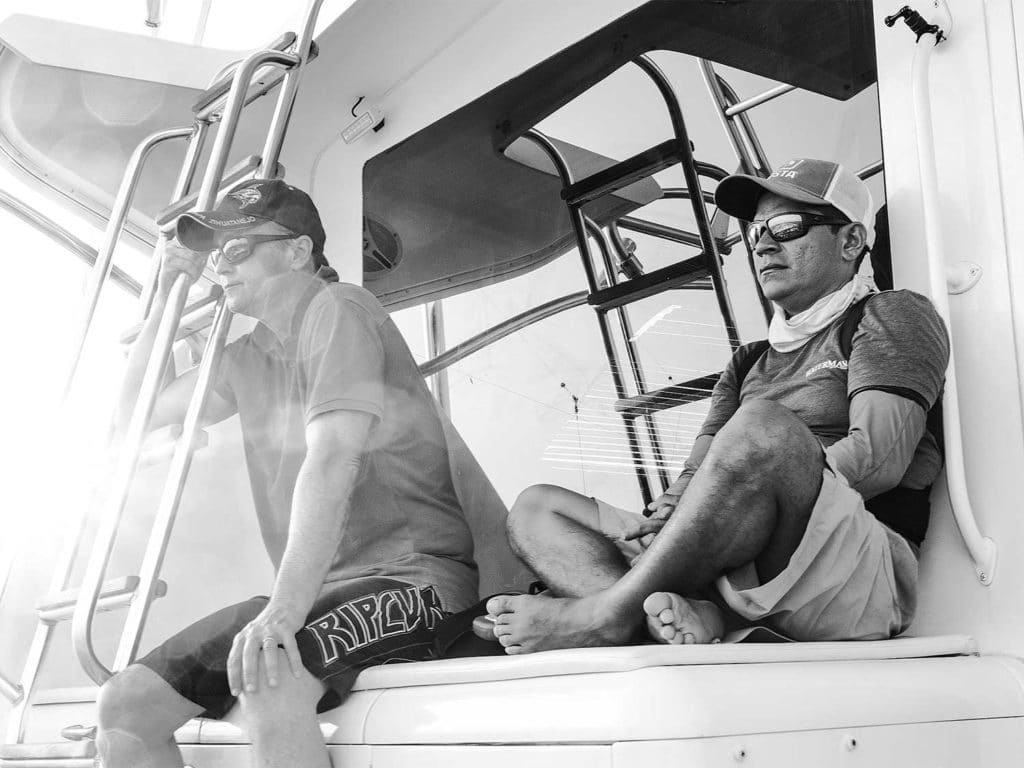
Once we started finding the underwater mountains, I was dumbstruck by the sight. Deja Blue is equipped with sounder displays in the cockpit beneath the bridge overhang and also in the salon on the television monitor, so we all had a good look at some absolutely unimaginable bottom structure, rising from 1,000 feet to within 500, 300, even 50 feet from the surface before plummeting back into the depths on the other side. Most of the seamounts were round or hotdog-shaped and anywhere from a half-mile to about 4 miles across.
We also marked huge masses of gamefish, most likely dogtooth tuna and giant trevally, on the shoulders of the seamounts—they would have to wait for another day, though. The sea conditions throughout the expedition remained the same: flat-calm.
“The seas are almost always flat here until the monsoon season rolls around, which is from mid-May through September,” Hall says. As the big Bertram rolled comfortably across the ocean, kicking up dozens of flying fish in the wake, we set the spread and went to work.
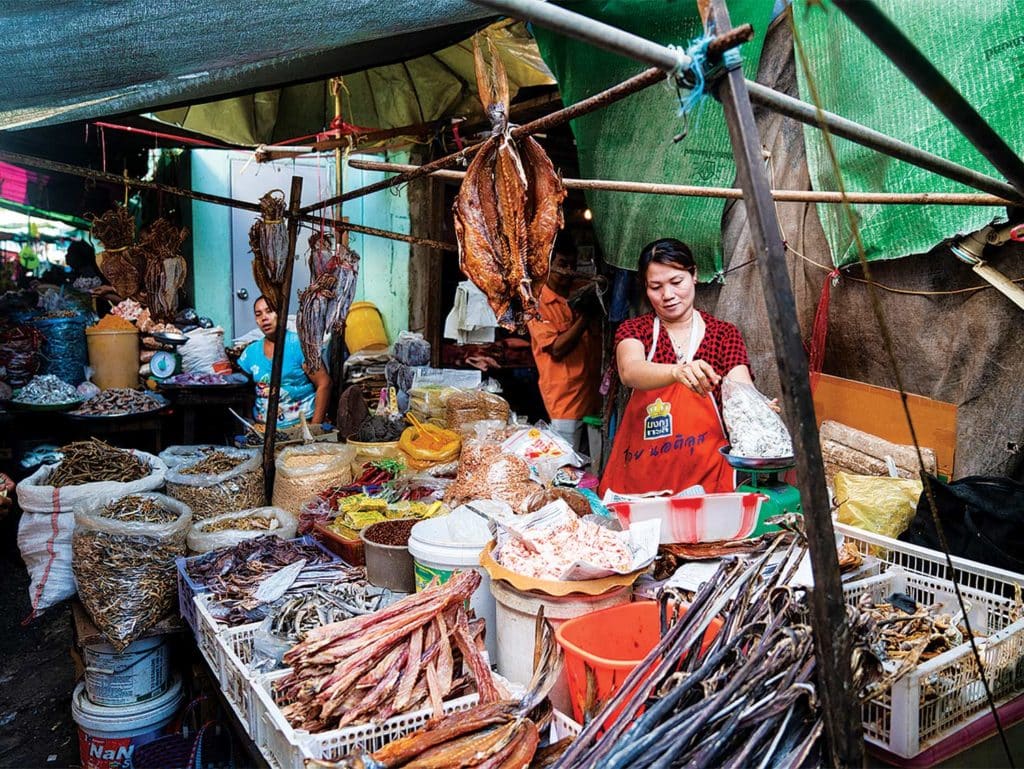
Find the Bait, Find the Fish
As with any other marlin-rich destination in the world, two factors play a key role: moon phase and the presence of bait. The first two days, we averaged a couple of marlin bites a day but it wasn’t gangbusters just yet. We caught black marlin on the tops and along the edges of the seamounts, but as soon as we swung out wide, the blue marlin led the charge. As the moon crept along toward full later in the week, the bite improved greatly; we were also able to find two seamounts in particular that held vast shoals of skipjacks, which also was encouraging. Now we could concentrate our efforts in specific locations.
Each evening, we would head to the shallowest spot we found to serve as an anchorage. It’s a unique feeling to be more than 100 miles offshore and still be able to see the bottom below the boat. After chef-prepared dinners of fresh seafood and outstanding Thai cuisine, we’d tumble back out to the cockpit each evening to drop a few lines for bottomfish, net flying fish in the underwater lights or just marvel at the near-spiritual brilliance of the Southern Cross in the dark sky.
“We released five blue marlin—including a pair of solid 500-pounders—and two black marlin, with the majority of the bites from pitch-baiting savage fish on the teasers.”
The last 2½ days offshore proved to be the best of the trip, with an improving moon phase and plenty of bait holding tight on productive structure. In that stretch of time we released five blue marlin—including a pair of solid 500-pounders—and two black marlin, with the majority of the bites from pitch-baiting savage fish on the teasers.
We lost a couple more on lures, including the largest fish of the trip, an estimated 600-plus-pound blue that came up jumping after exploding on a black-and-red Black Bart Breakfast trolled from the long rigger.
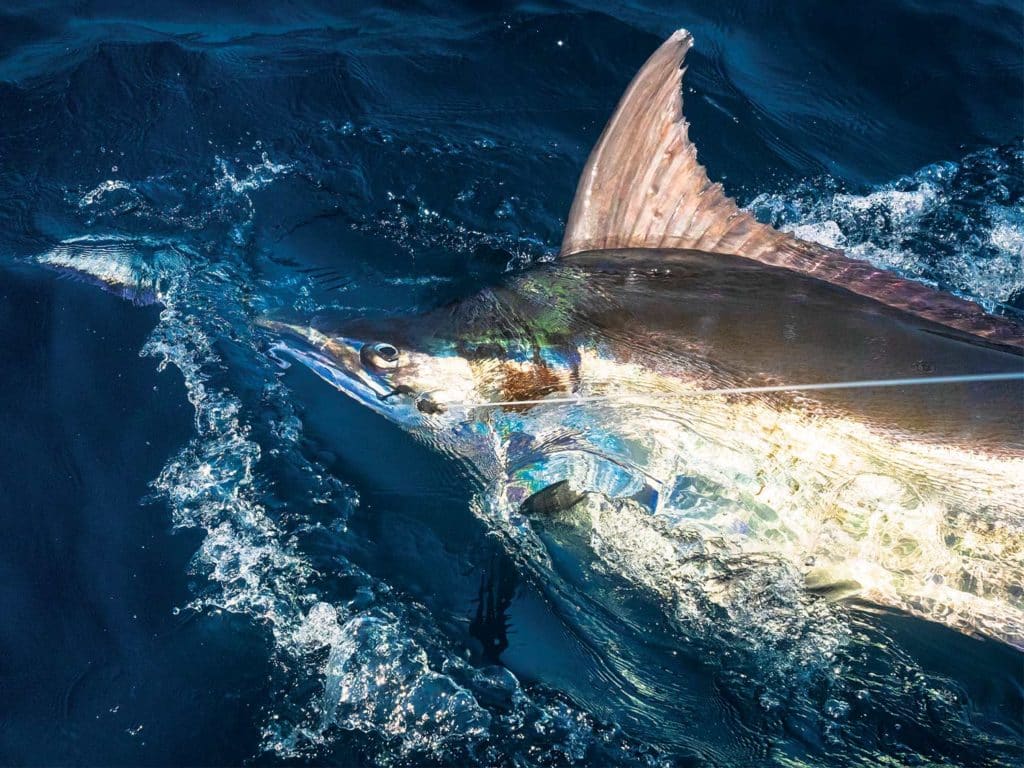
Give and Go
A few takeaways: First, the fishing potential in this region is undeniable. We tallied nine marlin releases in five full days of fishing, and saw or hooked and lost twice that many. We raised two doubles and caught one from each. But the numbers don’t really do it justice, because we spent the first few days scouting unknown waters. Once we found the bait, the action skyrocketed.
Commissioned in 2001, Deja Blue is set up well for liveaboard fishing, with staterooms converted to comfortable bunks, plenty of freezer and storage space, updated electronics, full commercial-grade SOLAS safety equipment and high-quality tackle ranging from light spinning gear to bent-butt 80s. We chose to fish stand-up with 50s and used lightweight Shimano Torsas for pitch-baiting, a perfect setup for this style of fishing. The teaser bites were absolutely insane.
The opportunities for many other species, and larger marlin, abound. We stopped during one day of trolling to deep-drop using Hall’s new Shimano BeastMaster electric reels and pulled up several unusual species from the depths, including a tasty dot-dash grouper that was a first for me. We didn’t have a chance to chase the dogtooth tuna, but this is one of the best spots in the world to target those pugnacious reef brawlers. On the anchorage, we caught bluefin trevally, coral trout, luna and a host of other colorful bottomfish.
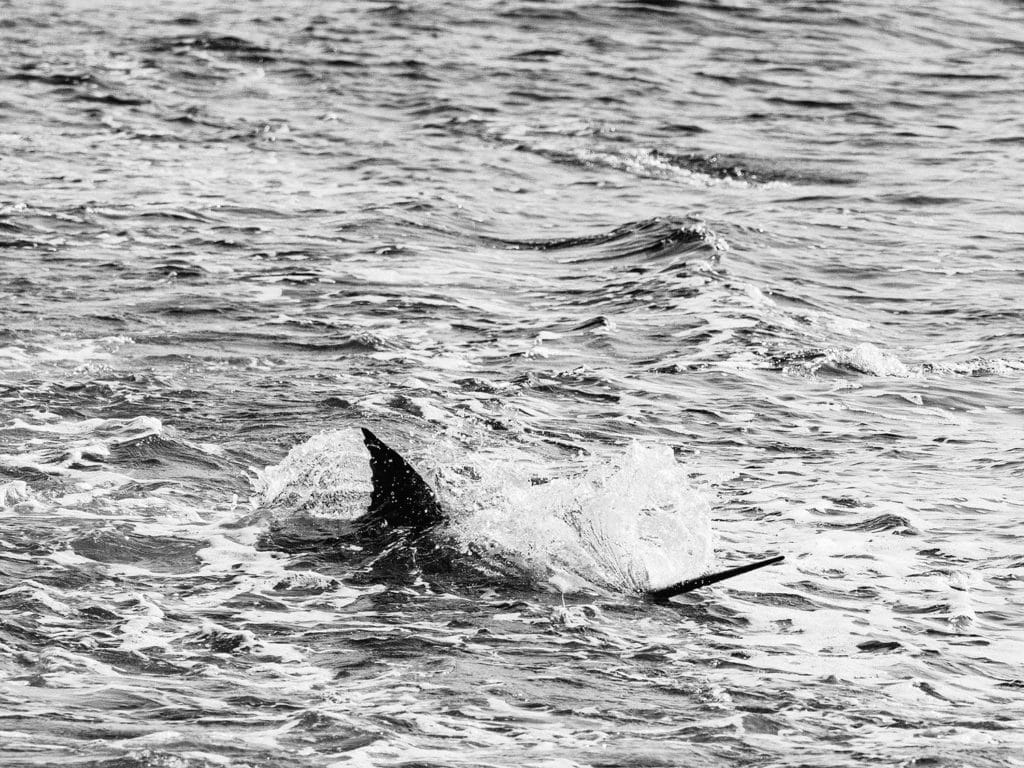
Swordfish also are found in good numbers throughout the Burma Banks. “We just need to put in our time and fine-tune our approach, but I’m sure we’ll catch swords here,” Hall says.
Given the number of seamounts and the clouds of baitfish and squid we marked deep every day, I couldn’t imagine that broadbills would not be far behind. The possibility for an Indian Ocean grand slam—blue marlin, black marlin and swordfish—was easily within reach.
“Nearly all of the marlin we encountered were aggressive fish in the 200-to 500-pound range, but I’m sure that larger ones are in the area.”
Nearly all of the marlin we encountered were aggressive fish in the 200- to 500-pound range, but I’m sure that larger ones are in the area. For someone interested in quality rather than quantity, live-baiting around the skipjack-filled seamounts would no doubt produce bigger fish. Hall has already added a set of removable tuna tubes to make that scenario much easier. The Blue Oceans operation has caught blue and black marlin to 900 pounds nearby in the Andaman Islands, with tales of granders fought and lost just offshore of the Burma Banks on the deeper drop-off.
In addition to Deja Blue, Blue Oceans also has a second gameboat, the 36-foot New Zealand custom-built Addiction, which also can be paired with a separate mothership. “Addiction was custom-built with marlin solely in mind and designed to be incredibly maneuverable,” Hall says. “She’s a perfect choice for light-tackle or fly anglers, especially for those anglers who are interested in chasing world records in flat-calm seas.”
See our first look at the Andaman Sea adventure here.
Liveaboard trips are a tremendous value if you really love to fish. This isn’t a standard eight- or 10-hour charter trip that has you back at the dock at the end of the day, but rather the opportunity to target an incredibly wide variety of species, for as long as you can stand it. Day or night, the action is virtually nonstop. With a professional chef in the galley, meals are five-star delicious as well. From November through May, Blue Oceans charters in the Andaman Sea, fishing out of Kawthaung, Myanmar. Once the monsoon season settles in up north, the operation moves to the other side of the Malaysian peninsula to Tioman Island in May, where it resumes fishing for marlin, sailfish and other species. The team is well versed in fishing and travel throughout the region.
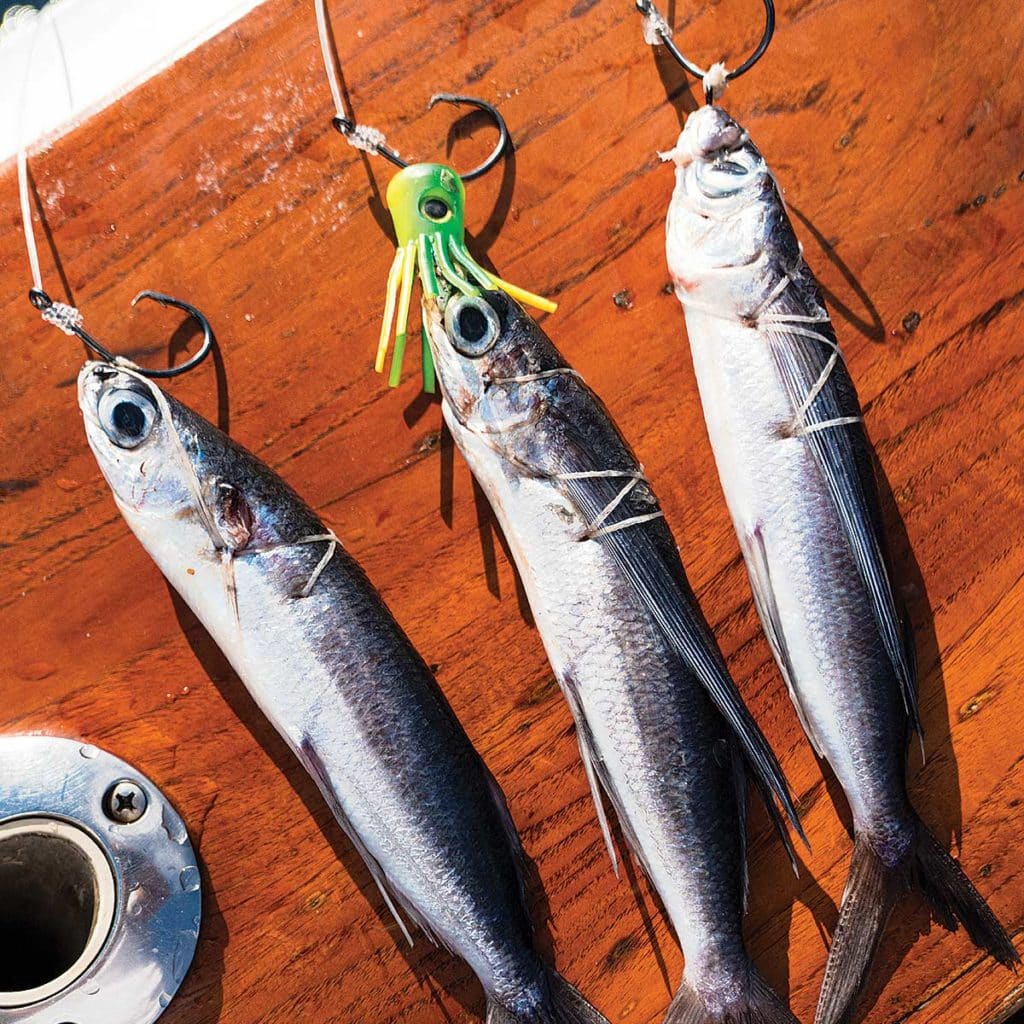
The Adventure
After a half-day chug to the east and a night anchored off the stunning Nga Khin Nyo Gyee Island in the Mergui Archipelago, we returned to our mooring off Kawthaung, Myanmar, and the group ventured ashore for some sightseeing and dinner on solid ground.
The town’s sprawling market was a unique adventure, with a seemingly never-ending vivid kaleidoscope of sights, sounds and aromas at every turn. The fishmonger stalls were especially interesting. We were treated like visiting celebrities, as I’m sure we were the only Caucasians in town that week—or maybe even that month.
Locals would sidle up to us for selfies, no doubt to show their friends that they had met the friendly white gringos from the big boat in the harbor. On the hilltop overlooking the city, we toured a centuries-old Buddhist temple, replete with 40-foot gilded statues of the rotund deity.
My fishing friends always ask if a journey such as this is worth the time and effort. My reply is that it entirely depends on your expectations. If you just want to have a few days marlin fishing with family or friends, probably not. The Andaman Sea is remote and requires two days of travel from the United States, plus the 100-mile transit on the boat before you put the first line in the water. With that said though, Southeast Asia in general, and Myanmar in particular, is simply intoxicating to the senses. Enjoy the entire experience. Spend some time sightseeing in Hong Kong and Bangkok en route to the coast. Visit the beautiful beaches of Phuket, or explore the numerous high-end resorts and islands in the Mergui Archipelago off Ranong. Then head offshore for the liveaboard marlin fishing trip of a lifetime. It’s a step into the unknown and a departure from just about anything you’ve ever seen before—an epic adventure of round-the-clock action that is sure to leave an indelible impression.
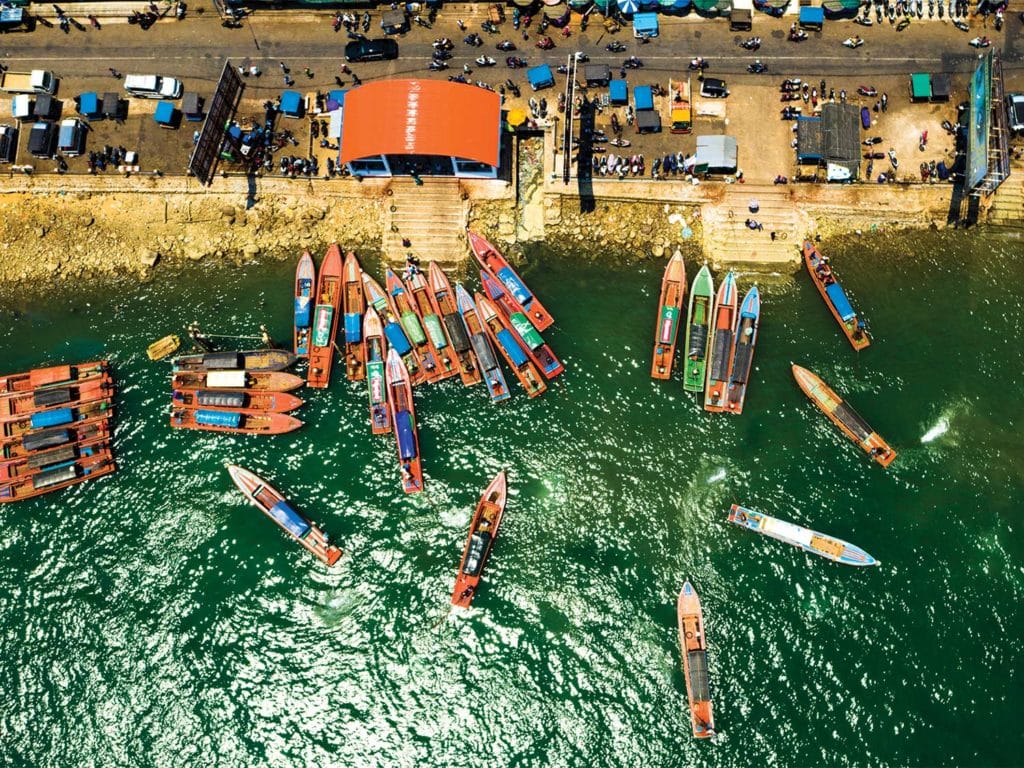
Travel to Myanmar
The Marlin team flew from John F. Kennedy International Airport in New York aboard Cathay Pacific Airways to Hong Kong, then to Bankok’s Suvarnabhumi International Airport. After a brief overnight stay at the comfortable Suvarnabhumiville Airport Hotel, we headed across the city to Don Mueang International Airport for the one-hour domestic flight to Ranong. (We flew Air Asia.) Alternatively you can fly into Phuket, Thailand, and connect to Ranong via private van, or fly to Yangon in Myanmar, then fly direct to Kawthaung.
A 15-minute bus transfer deposits you at the border crossing, where you check out of Thailand and board a long-tail skiff (right) to cross the Kra Buri River into Myanmar. Burmese customs officials will meet you at the boat on the mooring, where you surrender your passports and pick up a local guide for the trip offshore. The process repeats on the outbound side; if you’d like to spend a day in Kawthaung, the guide is happy to show you around town for sightseeing and shopping.
To learn about the fishery off Myanmar, visit blueoceans.club or send an email to [email protected]. Its travel professionals can handle all inquiries and do an outstanding job of not only answering questions but assisting with all travel, including international and domestic flights and ground transfers.




